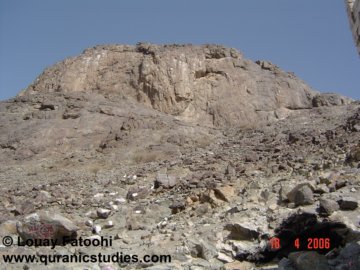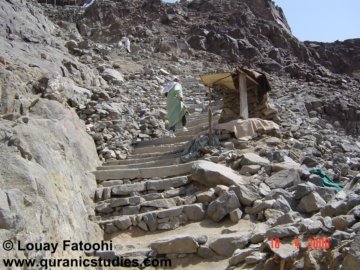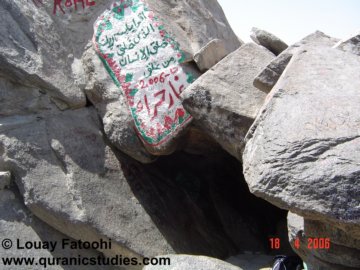The oldest surviving biography of Prophet Muhammad is that of Ibn Hisham (died 833 CE), which is a freely edited version of Ibn Ishaq’s (ca. 704 – 767 CE). In this biography, Ibn Hisham tells us that before the revelation of the Qur’an Muhammad used to retreat for a month every year in a mountain called Hira’ in Mecca. When he would finish his seclusion he would return to circumbulate the Ka‘ba seven times before heading home. One year, corresponding to 610 CE, the Prophet had retreated in Hira’ in the month of Ramadhan when he was visited by the ruhGabriel who read to him the first verses of the Qur’an to be revealed.
According to Ibn Hisham, Gabriel appeared to Muhammad in his sleep, carrying a book. He commanded him to “read.” Muhammad refused twice the order before finally asking what he was supposed to read. Gabriel replied with following verses of the Qur’an:
Read in the name of your Lord who created (96.1). He created man from a clot (96.2). Read and your Lord is the most honorable (96.3) who teaches by the pen (96.4). He taught man what he did not know (96.5).
Muhammad then recited the verses in his sleep. When he woke up, he felt as if the words had been engraved on his heart. On his way down from the mountain, the Prophet heard a voice from heaven saying: “O Muhammad! You are the messenger of Allah, and I am Gabriel.”
Al-Bukhari (810-870 CE), whose compilation of sayings and deeds of Prophet Muhammad is highly regarded by Sunnis, gives a slightly different account:
The commencement of the divine inspiration to the Messenger of Allah was in the form of good dreams which came true like bright day light, and then the love of seclusion was bestowed on him. He used to go in seclusion in the Cave of Hira’ where he used to worship [Allah alone] continuously for many days before he would desire to see his family. He used to take with him the journey food for the stay and then come back to [his wife] Khadija to take food for another stay, until suddenly the Truth descended upon him while he was in the Cave of Hira’. The angel came to him and asked him to read. The Prophet replied, “I do not know how to read.”
The Prophet added, “The angel caught me [forcefully] and pressed me so hard that I could not bear it any more. He then released me and again asked me to read and I replied, ‘I do not know how to read.’ So he caught me again and pressed me a second time till I could not bear it any more. He then released me and again asked me to read but again I replied, ‘I do not know how to read.’ So he caught me for the third time and pressed me, and then released me and said:
Read in the name of your Lord who created (96.1). He created man from a clot (96.2). Read and your Lord is most honorable (96.3) who teaches by the pen (96.4). He taught man what he did not know (96.5).
Then the Messenger of Allah returned with the inspiration and with his heart beating fast. Then he went to [his wife] Khadija bint Khuwailid and said: “Cover me! Cover me!” They covered him until his fear was over, and after that he told her everything that had happened and said: “I fear that something may happen to me.” Khadija replied: “Never! By Allah, Allah will never disgrace you. You keep good relations with your kith and kin, carry the weak, help the poor, serve your guests generously, and assist the calamity-afflicted ones.”
Although the overwhelming majority of scholars believe the verses of chapter 96 above are the first to have been revealed, others have disagreed. For instance, in his famous exegesis of the Qur’an, At–Tabari quotes some who insist that the first verses of chapter 74 were the first to be revealed. In addition to his citation of those who argue that it was the verses of chapter 96, Al-Bukhari also quotes a number of transmitters of Prophetic sayings who claim that those verses of chapter 74 were revealed first:
[The Messenger of Allah] said: “I went to stay in Hira’. After finishing my stay, and while I was coming down, I was called upon. I looked right, left, in front, and behind, but could not see anyone. But when I raised my head I saw something. I then came to Kadhija and said: ‘Cover me, and pour cold water on me!’ He said: “They covered me and poured cold water on me.” He said: “Then the following verses were revealed: ‘O you who are clothed (74.1)! Arise and warn (74.2)! And your Lord do magnify(74.3).’”
In his interpretation of verse 96.1 in his renowned exegetical work, Al-Qurtubi (died 1272 CE) adds another two opinions one of which claims that chapter 1, known as Al-Fatiha, was the first to be revealed, and the other claims it was verse 6.151. The majority of scholars, however, believe that the verses of chapter 96 were first revealed.
Despite the conflicing accounts and the impossibility of finding out the exact details of the first revelation of the Qur’an, Muslim scholars and historians have not disputed the fact that the Prophet used to retreat to the Mountain of Hira’ for worship, and the overwhelming majority agree that it was during one of those seclusions that the first verses of the Qur’an were revealed. The books of Prophetic sayings also mention at least two instances after the revelation of the Qur’an in which the Prophet went on Hira’. In one instance he was with a group of his companions when the mountain shook, and in another he was alone when he recited the Qur’an to a group of jinn on that mountain.
Muslims over the centuries continued to climb to the top of the 600-meter high Mountain of Hira’ to visit the cave where the Qur’an was first revealed and to seek blessings. The name Hira’ has become used almost exclusively for that cave, whereas the mountain has become known as the “Mountain of Nur (Light)”, in reference to the revelation of the light of the Qur’an.
I first visited the cave in 2001, when I went for pilgrimage with my wife. I visited it again when we went for ‘umra in 2006, which is when I took the photos in this article. Mecca is in a valley surrounded by desolate hills and mountains, so even when we were getting very close to the mountain we needed our taxi driver to point it out for us. Image 1 shows the mountainous and hilly terrain of that area as seen from the Mountain of Nur:

Image 1 (click to enlarge): A view of the surrounding terrain from the Mountain of Nur

Image 2 (click to enlarge): The peculiar looking summit of the Mountain of Nur
Climbing the mountain today is much easier than it used to be. Many pilgrims over the years have volunteered to pave the way for visitors. A relatively easy path has been made for a considerable part of the journey, and the friendliest route has been well marked. Some parts of the path have even been turned into relatively easy-to-climb steps:

Image 3 (click to enlarge): Steps made by pilgrims for fellow pilgrims for easier access to the Cave of Hira’

Image 4 (click to enlarge): You need to climb to the summit of the Mountain of Nur to descend to The Cave of Hira’

Image 5 (click to enlarge): The steps leading to the narrow path to the Cave of Hira’

Image 6 (click to enlarge): The narrow, rocky path leading to the Cave of Hira’
Once you have squeezed yourself through the 3-meter long narrow path to the other side of the rocks you first come to a little open courtyard that is roughly 3×2 meters. At the end of this court is the cone-shaped cave. It is surrounded from the top, right, and left with the same building blocks of that place: large, heavy rocks. It is over 2 meters deep, and about 1.5 meters wide at the beginning, but less than a meter at the front end. It is too small for more than one person to stand comfortably to pray:

Image 7 (click to enlarge): A pilgrim is praying at the entrance of the cave, surrounded by others waiting for their turn to pray

Image 8 (click to enlarge): A straight view of the cave from the courtyard

Image 9 (click to enlarge): A side view of the cave from the courtyard

Image 10 (click to enlarge): A view of the courtyard taken from the front end of the cave
The top of the Mountain of Nur in that mountainous desert is surely one of the loneliest places. But the cave, and even the courtyard, is even more isolated. If you stand in the courtyard, you can only look over the surrounding rocks at the desert or, these days, building that are hundreds of meters down and hundreds of meters to many kilometers away. If you sit down, the surrounding rocks are just too high to see anything other than the sky. Inside the cave you are completely surrounded by those rocky walls. It is total isolation and complete emptiness. There is nothing of this world there to see or get distracted by — the ideal place for someone who wanted to forget the world and focus on what lies beyond the present, visible, and material.
No one can stay there even for a minute or two without feeling lonely. In my second visit, which took place when we went for ‘umra, the pilgrims who were there before me left at some point and I found myself on my own for about 5 minutes before new visitors started to arrive. It was so lonely. You do not see or hear anyone, and you feel so apart from the rest of the world. It can be scary in the morning, but it must be utterly terrifying in the night. This is the place that Muhammad frequented and lived in for days and probably weeks, day and night. He wanted to be alone, away from all people, because he was seeking a different company. This is where Muhammad sought and worshipped Allah, the only God, who was going to inspire him, make him His last Prophet, and reveal the Qur’an to him.
Visiting the Cave of Hira’ was one of the most moving and memorable experiences of my pilgrimage and later ‘umra. Having seen how well hidden the cave is, even to someone at its path, there is no way Muhammad, looking up from the bottom of that mountain, could have guessed that somewhere near the summit of that mountain there was a totally isolated cave. We do not know whether he climbed up the mountain looking for the cave he felt existed and needed to find, or whether he was made to find it having been led to explore that summit. But what is certain is that Muhammad must have been drawn to the cave. Allah wanted him to find the cave and make it the private abode that he would frequent to be on his own with Him and think of the spiritual matters that preoccupied him.
My first visit to the cave left me with an overwhelming sense of amazement, reverence, and awe. The belief that it was Allah who led Muhammad to the cave was so intense. But the impact of what I saw and learned about that breathtaking cave and the Prophet’s miraculous journey to its discovery was too strong to easily neutralize by my knowledge that this miracle, like anything else, is easy for Allah to do.
As this visit was during the pilgrimage season and its arresting religious atmosphere, it was normal to find oneself thinking of and remembering Qur’anic verses. But it was still unusual that for the rest of that day one particular verse kept appearing in my head:
Or, do you [O Muhammad!] think that the People of the Cave and Raqim were too wonderful for Our signs? (18.9)
The reference to the “cave” in the verse should have made me figure out why I kept remembering this particular verse. But I did not realize the link until I told my wife Shetha later that night about the verse I could not forget. She drew my attention to the similarity between my experience in the morning with the cave, which I never stopped talking about all day, and what that verse says.
This is the verse with which Allah starts recounting the story of a group of young men who escaped persecution to a cave and whom Allah put to sleep for 309 years. Interestingly, while “Raqim” is taken by many exegetes to mean “inscriptions,” some have suggested that it might be the name of the “mountain” on which that cave was situated. The verse tells us that as strange as this miracle may look, we must not be surprised by what Allah can do, for He can do anything. I think what was particularly overwhelming for me is how close, visible, and tangible the miracle of the cave was. It is not so often that you can touch a miracle!
In the same way that Muhammad could not have sought and found the cave, he could not have sought and obtained the Book that was revealed in that cave. If he could have really made any choice at all, he could have only chosen to be chosen!
Copyright © 2007 Louay Fatoohi
Blog: http://www.louayfatoohi.com
![]() http://www.facebook.com/LouayFatoohiAuthor
http://www.facebook.com/LouayFatoohiAuthor
![]() http://twitter.com/louayfatoohi
http://twitter.com/louayfatoohi
![]() http://www.instagram.com/Louayfatoohi
http://www.instagram.com/Louayfatoohi
Website: http://www.quranicstudies.com
All Rights Reserved.

